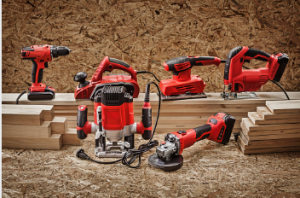Using a jigsaw is beneficial for some reasons. For starters, it’s a convenient tool for making all types of cuts. Jigsaws come with various types of blades, including reverse and standard. A standard jigsaw blade is designed to cut material on its upstroke. On the other hand, the reverse blade has teeth that point downward, reducing the chance of nicking or chipping.
Jigsaws are a more versatile tool than circular saws
ToolKitDepot jigsaws are one of the most versatile power tools, offering many different types of cuts. They can make extended straight and curved cuts and are often lightweight and portable. They are beneficial for delicate work and small projects around the house. However, a circular saw will be more suitable if you build a large structure.
 The cutting power and precision are the main differences between a circular saw and a jigsaw. A circular saw is designed to produce precise straight cuts and is a better option if you work with complicated curves. A circular saw is also more versatile than a jigsaw for smaller DIY projects. You can even use two circular saws in tandem for better results.
The cutting power and precision are the main differences between a circular saw and a jigsaw. A circular saw is designed to produce precise straight cuts and is a better option if you work with complicated curves. A circular saw is also more versatile than a jigsaw for smaller DIY projects. You can even use two circular saws in tandem for better results.
ToolKitDepot jigsaws are also more powerful and durable than circular saws. They also come with a cord, convenient for those who don’t want to deal with extension cords. However, cordless tools also tend to be less expensive, requiring additional batteries. And cordless tools can quickly drain the battery, which is not the best option for heavy-duty projects.
They can cut metal, fibreglass, laminate, and tile
Jigsaws are a great way to cut all materials, including metal, fibreglass, laminate, tile, and more. The proper blade will cut these materials easily. A carbide-tipped blade is best for cutting fibreglass, but a high-carbon steel blade will work just as well.
The blade type you choose is critical when cutting laminate. Tooth-style blades will cause excessive edge damage when cutting through the laminate. In addition, you will have to change blades frequently because a tooth-style blade can get clogged with resin. The best choice for cutting laminate is a tungsten carbide blade, which will cause the least damage to the edge.
Jigsaws have many different blade types, allowing you to cut many different materials. The jigsaw blade allows you to cut curved lines in wood, metal, fibreglass, and laminate. Jigsaw blades can also cut tile and ceramic. It makes them more versatile than tile cutters, which can cut through tile but cannot cut metal.
They can make bevelled cuts.
A jigsaw is a tool that can be used to make bevelled cuts and crosscuts. Its cut is not as clean as that of a mitre saw. The drawback of a jigsaw is that it is a slow machine. However, it is ideal for cutting bevels and crosscuts.
Jigsaws can make bevel cuts up to 45 degrees. They work by intentionally setting the blade to the desired angle. Bevelled cuts are an excellent way to join two pieces of material at a 45-degree angle or to create a decorative edge finish. The angle of the cut is adjusted using the shoe pivoting mechanism.
Before cutting the material, ensure you have marked the shape of the cut. A T-square will help to mark the cut. You can also mark the desired shape with a pencil. Bevelled cuts require more precision than straight cuts.
They generate dust
While jigsaws do not produce as much sawdust as other saws, they generate some. It is because they take chunks of wood from the cutline, and the dust results can be challenging to see. Some jigsaws come with dust blowers that direct air toward the cut point and improve visibility. Others have a dust extraction port for capturing small pieces of debris.
ToolKitDepot jigsaws have a small width and therefore need to be placed in an area free of debris and dust. You should also pay close attention to the height and stability of the workbench you choose. A good jigsaw should be at the correct working height and well-ventilated.
When you use a jigsaw, you should always wear safety gear. It includes eye protection and a dust face mask. Jigsaw blades are smaller and do not produce as much dust as circular saw blades. Moreover, they are less expensive than circular saw blades.
